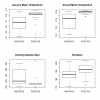Terra and Aqua satellites track tiger mosquito invasion: modelling the potential distribution of Aedes albopictus in north-eastern Italy
- PMID: 21812983
- PMCID: PMC3170180
- DOI: 10.1186/1476-072X-10-49
Terra and Aqua satellites track tiger mosquito invasion: modelling the potential distribution of Aedes albopictus in north-eastern Italy
Abstract
Background: The continuing spread of the Asian tiger mosquito Aedes albopictus in Europe is of increasing public health concern due to the potential risk of new outbreaks of exotic vector-borne diseases that this species can transmit as competent vector. We predicted the most favorable areas for a short term invasion of Ae. albopictus in north-eastern Italy using reconstructed daily satellite data time series (MODIS Land Surface Temperature maps, LST). We reconstructed more than 11,000 daily MODIS LST maps for the period 2001-09 (i.e. performed spatial and temporal gap-filling) in an Open Source GIS framework. We aggregated these LST maps over time and identified the potential distribution areas of Ae. albopictus by adapting published temperature threshold values using three variables as predictors (0°C for mean January temperatures, 11°C for annual mean temperatures and 1350 growing degree days filtered for areas with autumnal mean temperatures > 11°C). The resulting maps were integrated into the final potential distribution map and this was compared with the known current distribution of Ae. albopictus in north-eastern Italy.
Results: LST maps show the microclimatic characteristics peculiar to complex terrains, which would not be visible in maps commonly derived from interpolated meteorological station data. The patterns of the three indicator variables partially differ from each other, while winter temperature is the determining limiting factor for the distribution of Ae. albopictus. All three variables show a similar spatial pattern with some local differences, in particular in the northern part of the study area (upper Adige valley).
Conclusions: Reconstructed daily land surface temperature data from satellites can be used to predict areas of short term invasion of the tiger mosquito with sufficient accuracy (200 m pixel resolution size). Furthermore, they may be applied to other species of arthropod of medical interest for which temperature is a relevant limiting factor. The results indicate that, during the next few years, the tiger mosquito will probably spread toward northern latitudes and higher altitudes in north-eastern Italy, which will considerably expand the range of the current distribution of this species.
Figures







References
Publication types
MeSH terms
LinkOut - more resources
Full Text Sources
Medical
Miscellaneous

